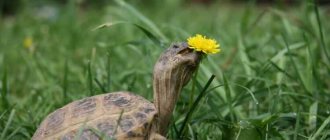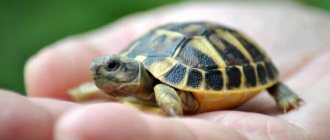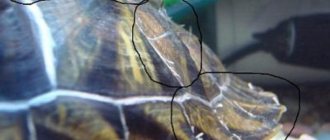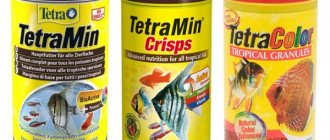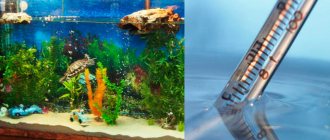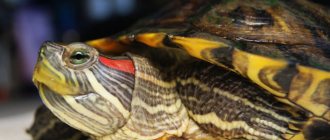The red-eared slider is the most common species of pet turtle.
This reptile has a medium size, interesting color and has a fairly high level of intelligence. In intelligence it is superior to many other species of its own kind. The red-eared one appeared in artificial terrariums many years ago; now such a pet can be purchased at any pet store. She is considered a long-liver: under favorable conditions, the pet can live thirty - forty (30 - 40) years. However, many owners of such a reptile do not know how often, what and in what quantities to feed their red-eared turtle . In our article we will try to answer this important question.
Keeping a red-eared turtle at home
For a pet to live at home, many different accessories are required, some of which are quite expensive. But it all depends on the manufacturer. Below is a list of mandatory things that are necessary for keeping and caring for an animal:
- aquarium;
- 100 Watt water heater;
- filters;
- UV lamp;
- pet heating lamp;
- thermometer;
- lamp;
- island, shore and land.
Components of an aquarium for a turtle
The list is quite impressive, but every detail is necessary.
Aquarium
A pet needs a large aquarium, optimally 200 liters. For a small turtle that has just been purchased and brought home, 10–15 liters will be enough. To avoid unnecessary hassle, it is better to accustom your pet to a large house in advance. This will make it easier for him to swim, since the animal must move and develop its muscular system and not become obese.
The water level must be adjusted so that the pet can stick its muzzle out of the water while standing on its hind legs. If the aquarium is initially deep, you can put a piece of wood or stone on the bottom.
Aquarium for turtle
When choosing soil, pay attention to its size and do not use small stones. In the process of eating and collecting food from the surface, a turtle may get carried away and start eating stones, which will lead to death or illness
You also need to be especially careful when choosing algae for the aquarium, because many species, for example, Elodea or Ambulia, are poisonous to aquarium reptiles
Lamps
In order for a turtle to produce Vitamin D, it needs to be exposed to ultraviolet light. Since there is enough similar lighting in nature, when keeping a turtle at home, it needs to be created. In this case, household lamps will not be useful, since they are difficult to position along the entire length of the aquarium.
Ultraviolet lamp location
The most popular lamp for lighting an aquarium in which reptiles live is Repti Glo 5. For comfortable lighting, you need to place the lamps at a distance of 40–50 cm from each other. Also, lighting and heating play a significant role in the process of metabolism and other functions. If your pet doesn't have enough light and heat, he may hibernate and his activity will decrease.
Island
Pet stores offer a wide selection of aquarium islands to suit every taste and budget.
But when buying, be sure to pay attention to the material of manufacture. Also, the main indicator of reliability is the method of attachment to the bottom of the aquarium.
For example, good islands have suction cups on the bottom, which help prevent the island from slipping on a wet surface.
But keep in mind that when the turtle grows and its weight reaches 1 kg, the suction cups will constantly come off, and the island will float throughout the aquarium. Therefore, instead of an island, it is better to use a special bridge-platform on which the turtle can climb and move.
Island with suction cups
When installing such a platform, it is necessary to install a ladder to it, which will not interfere with the pet’s swimming in the water. The reptile will sit on it when it is already too hot under the lamp.
Filter and heater
These two important components must be selected based on the volume of the aquarium and the amount of water in it. Modern pet stores offer filters that allow you not to change the water for a very long time. If the filter is placed outside the aquarium, it requires much less maintenance. And you can be sure that the turtle will not accidentally or intentionally remove it from the mount, bite the wire and eat the suction cup. If we talk about the heater, it needs to be set automatically to regulate the water temperature from 21 to 27 C.
You should always monitor the cleanliness of the water in the aquarium. After all, pets sleep, eat and even mate in water. The filter will help make the water cleaner, because dirty water is a source of infection and the spread of bacteria.
Lamps and lighting
In the wild, red whales live in the tropics, so sunbathing plays a very important role in their lives. Thanks to the sun's rays, reptiles receive a dose of ultraviolet radiation, which is involved in the process of calcium absorption.
At home, the red-eared turtle needs artificial sources of ultraviolet light and heat. For these purposes, 3 types of lamps are used:
- Ultraviolet (UV).
A lamp with a power of 5% UVB is enough for turtles, while larger individuals need a model with a power of 10% UVB. Such irradiation prevents the development of rickets and improves metabolism. - Warming
. Used all day for warmth when the reptile is doing its business in the water or on land. - Infrared
. Unlike an incandescent heating lamp, it does not provide enough light. It is used only for the purpose of heating the aquaterrarium at night, when the temperature drops below acceptable levels.
When installing and using a heating and UV lamp, it is important:
- Place the equipment at a distance of at least 30 cm from land. At closer proximity, the pet's retina is at risk.
- Take care of waterproofing. Flying splashes may damage the lamp.
- Maintain a working time of 10-12 hours.
Feeding frequency of the red-eared slider
One of the main causes of many reptile diseases? banal overfeeding with protein foods. Excessive nutrition can lead to pyramidal carapace, obesity, tympany, etc. Excess food is especially dangerous at a young age, during the period of active development.
Young red-eared turtles (up to 12 cm in size at the plastron and up to one and a half years old) are fed every day only once in the morning or afternoon. The serving size directly depends on the pet’s appetite and liveliness. Give enough food at a time so that the reptile eats it within half an hour. As a rule, these are 2-3 pieces of fish measuring 1 cubic meter. cm. In case of lack of appetite in a young turtle, the portion size is reduced or a small hunger strike is arranged for 1-2 days.
Adult turtles, aged from one to one and a half years, are gradually transferred to feeding the main food once every few days. At the same time, there may be plant food in the terrarium so that the reptile can eat on the remaining days.
In natural conditions, red-eared turtles feed on both plant and animal foods.
When keeping these animals at home, it is important to properly organize their diet so that it is as close to natural as possible in terms of calories and the content of essential nutrients. Red-eared turtles living at home need a balanced diet, including all the substances they need. In nature, the animal can independently find sources of vitamins and minerals for itself, but at home you should take care of this
Red-eared turtles are fed mainly with animal food: tubifex, earthworm, coils (small snails), mussels, zofobas squid. The main food is raw, lean fish. Fat content, which is up to 3.0%. (hake, blue whiting, pollock, cod, perch (freshwater), and many other fish) It is advisable to give the fish with giblets. The best RIVER FISH. Also: chicken or beef liver, raw green shrimp, and with a shell for calcium. You can introduce live food, small fish (guppies), and let them hunt. Also, for calcium, you can give chopped, crushed fish ridges (if they are very large), and you need to cut off the long sharp ribs from the ridge! A good source of calcium is the so-called “Sepia” - this is cuttlefish bone, which can be bought in poultry departments, but without any additives! https://vk.com/photo-92141466_362493610 Just throw it in the aquarium and let the turtle chew whenever he wants. You can also offer greenflies: lettuce, dandelion leaves, plantain, seaweed, duckweed - for coarse fiber. You can throw duckweed directly into the aquarium and let it float. The diet of aquatic turtles must include insects: mealy bug larvae, various beetles, grasshoppers. Do not allow pet poisoned cockroaches!
Liver once a week to prevent vitamin deficiency; give zophobas rarely, it is very fatty.
In summer, turtles benefit from feeding grasshoppers, beetles, non-hairy caterpillars and other non-poisonous insects.
How many times to feed your turtle: Baby turtles should be fed once a day. The best time for feeding is when it has woken up and warmed up on land, therefore the turtle then climbs onto land again to digest the food. If you feed in the evening, then the lamps should be on for about two more hours, so that she also has time to digest the food before the lamps turn off.
The portion should be no more than a turtle's head.
Adults are more than 2 years old and are fed 2-3 times a week. If the turtle has reached 12 cm in shell, then feed it every other day.
Everything is raw! Do not cook or fry anything! And only then will your turtle be as happy as this one...)
Health, disease and prevention
Almost 90% of all diseases of the red-eared turtle occur as a result of improper maintenance or failure to comply with care requirements. The presence of dirty water in an aquarium quickly causes a sharp deterioration in the turtle's health.
A sick aquatic animal must be kept at a temperature increased by about 2-3°C, which helps to improve the functioning of the immune system. It is also necessary to monitor the turtle's drinking regime, since dehydration can cause the death of a freshwater turtle due to the rapid development of kidney failure.
The animal's ill health is evidenced by the characteristics of the movements of a swimming red-eared turtle. A sick pet most often moves in a position “on its side” or simply sinks to the bottom. If an infectious nature of the disease is suspected, all animal care items should be thoroughly treated with an antiseptic that is safe for pets. As a rule, the first symptoms of a bacterial infection are represented by the appearance of edema and necrotic changes. In this case, a treatment regimen with antibiotics is prescribed, and the water in the aquarium is completely replaced.
When injured, a red-eared turtle, under the influence of an infection that has entered the body, develops blood poisoning, accompanied by redness of the paws and very pronounced lethargy. This pathology is classified as difficult to treat and therefore requires urgent and qualified assistance from specialists. Untimely treatment often causes the death of a pet as a result of dysfunction of internal organs.
Preventive measures are presented:
- daily inspection of the turtle;
- regular cleaning of the aqua terrarium;
- regular change of water in the aqua terrarium;
- proper organization of nutrition;
- preventing hypothermia;
- regular checking of the performance of illuminators, as well as heating and filtering devices;
- observing the rules of personal hygiene when caring for a pet;
- systematically cleaning the turtle shell from algae;
- mandatory quarantine for sick or newly acquired turtles;
- limiting the contact of a sick turtle with any other pets and family members;
- control of the animal’s movement outside the aqua-terrarium;
- periodic ultraviolet irradiation and sunbathing;
- regular examination by a veterinarian.
If the diet is incorrectly prepared, the freshwater animal develops calcium deficiency, which manifests itself in the form of curvature or severe softening of the shell. Too much calcium deficiency greatly increases your red-eared turtle's risk of death. In order to quickly normalize the general condition of the reptile, the veterinarian prescribes calcium supplements in injections.
How often?
And another significant issue for turtle owners is the frequency of feeding. Here, there is no need to focus on how often the red-eared turtle feeds on something, if you do not put restrictions on it - these creatures are not endowed with increased intelligence, and eat as much as food appears within reach.
Therefore, it is recommended to give food to very small turtles a couple of times a day, and to those that have reached adulthood – once every two to three days (but in sufficient quantities).
The volume of food is the size of 2 pet heads.
Between main meat meals, you can feed with plant foods - washed duckweed, pieces of vegetables or fruits. And don’t be afraid to leave your pets hungry – it’s even good for them; overfeeding is much more harmful than underfeeding!
Author - Dasha Blinova, website www.sympaty.net - Beautiful and Successful. This article has been checked and approved by a veterinarian. Knyazeva Anna Vladimirovna, veterinarian in private practice, Moscow. Learn more about the site's authors. Copying this article is prohibited!
Aquaterrarium
This is the correct name for the place where the red-eared turtle should live. Aqua- (water) and terra- (earth) - the turtle should be able to swim and crawl onto the shore (island) as needed. The volume of water for an average-sized turtle needs at least 60 liters, the container is mainly of a horizontal type. The older the turtle, the more time it spends on land, which means it makes sense to increase the island as the pet grows.
Aquaterrarium for the red-eared turtle.
Another important point is maintaining water quality. Little Reds are assholes! They eat sloppily, poop and pee a lot, so maintaining water quality is a top priority. The following things will help you achieve cleanliness in your aquarium.
- Filter. Optimally - internal, with a good flow reserve (3-4 volumes per hour) and a large sponge. There is no reason to install an external filter: anyway, it will not be possible to completely close the nitrogen cycle (as in an aquarium with fish), and the cost of good external filters is very high.
- Feeding outside the aquarium. Teach your animal from a very early age to receive food in a separate container. It is better to take water into the container directly from the aquarium - this way you will maintain the usual chemical and physical parameters of the water. After feeding, the water should be poured out of the container and fresh water should be added to the aquarium. This way, scraps are prevented from getting into the living space and at the same time a kind of “ventilation” is carried out by replacing part of the water.
- It is useful to change the water from time to time - about half the volume weekly. Fresh water should be at the usual temperature. In a large aquarium, it is convenient to do the change using a large hose - drain the required amount of water into a bucket or directly into the toilet and pour it back through the same hose directly from the tap, if you have coarse water filters in your house. If there are no filters, then cold water is mixed with boiling water in a separate bucket until the desired temperature is reached. Water conditioners should be used in spring and autumn, when melted snow or heavy precipitation from city streets enters the central water supply. It is very inexpensive to use pond conditioners - they do not differ in composition from aquarium conditioners, but are more concentrated. The air conditioner is calculated based on the volume of water being replaced, and not on the entire volume of the aquarium.
- It is permissible for turtles to change the water completely. If you missed changes and/or the water has an unpleasant odor, you can completely change the water by wiping the decorations and walls of the aquarium with a sponge. When completely changing the water, it is also advisable to use an air conditioner. There is no need to constantly wash the aquarium - the water should normally have a pleasant “living” smell, like a lake or a slow-moving river.
Feeding frequency of red-eared turtles
How often you need to feed depends on the age of the pet, the type of food, and the time of year.
Small reptiles, whose age is less than a year or whose size is up to 10-12 cm (the red-eared turtle is measured by the abdominal shield of the shell), need to be fed 1-2 times a day, every day.
Serving sizes depend on your pet's activity. Experts advise that in order to find out the amount of food for one feeding, you need to track how much the animal eats in half an hour and give that much each time. The approximate amount of food is equal to half the reptile's shell.
If a young turtle ignores food and does not eat, then it is worth reducing the portion size and keeping the pet hungry for 1-2 days.
If the red-eared turtle is older than a year, then it should be fed 2-3 times a week. At the same time, the terrarium should have plant food that the pet can eat whenever it wants.
The older the red-eared turtle is, the less often it needs to be fed, up to once a week.
But you need to take into account that reptiles have different appetites, so it is important to carefully monitor your pet: the turtle communicates what it wants to eat by its behavior
She shows activity when she sees her owner, tries to attract attention to herself in various ways, hits the water with her paws and splashes, but as soon as you feed her, she calms down. Thus, the reptile can ask for food every day, or maybe once every 7 days
When an adult refuses food, it is advised to reduce the amount and give it less often.
It must be remembered that the red-eared turtle is diurnal and the rate of its metabolism depends on the temperature, so it should be fed in the morning or during the day, but if you give it food before turning off the lamp, then there is a possibility that the food will not be digested, but will settle in the stomach and will begin to rot.
How much red-eared turtles eat depends on the time of year: in spring and summer they eat more, and in winter less, as they hibernate.
If the turtle is exhausted, then it should be fed every day, the amount of food should be as much as the pet will eat.
Basic rules for bringing pet turtles out of hibernation
For 3-4 months it hibernated indoors at a temperature of +6-10C; during the period of hibernation or hibernation, the pet lost about 10% of its weight. By the time the reptile leaves the hibernation, the reptile’s body is exhausted, therefore, in order to safely wake up the red-eared or Central Asian turtle, it is necessary to carry out the following steps step by step.
Smooth increase in temperature
In the wild, reptiles wake up when the air temperature gradually rises; the same principle applies in March, when it is necessary to bring the turtle out of hibernation. Within a week, it is necessary to bring the temperature in the terrarium to +20C, and then 3-4 days later to 30-32C. This process is done gradually; the container with the sleeping reptile is first transferred to a place with a temperature of 12C, then 15C, 18C, etc. You cannot place a sleepy turtle in a terrarium with a temperature of +32C, such a sharp drop will instantly kill the pet.
Taking baths
The body of an exotic animal is severely exhausted after a long hibernation; in order to completely awaken a land turtle, it is recommended that the awakened reptile take baths lasting 20-30 minutes in warm water with glucose. Water will saturate the animal’s body with life-giving moisture, the animal will remove urine, and hygiene procedures will raise the overall tone of the body. After bathing, the pet must be immediately placed in a warm terrarium, excluding the possibility of drafts.
In order to bring the red-eared turtle out of hibernation, after the stage of raising the temperature in the aquaterrarium, it is recommended to bathe the animal daily for 40-60 minutes in warm water for a week. It is strictly forbidden to fill an aquarium full of water with a sleepy reptile, which may choke and die.
A course of restorative drugs
After waking up, the body of an exhausted turtle is susceptible to various infections, viruses and pathogenic fungi. During hibernation, the animal lost a huge amount of energy and moisture, therefore, in order to bring a land turtle or red-eared turtle out of hibernation without complications, herpetologists prescribe the animal a course of vitamin preparations and electrolytic solutions. These measures are aimed at restoring the required amount of fluid and stimulating the reptile’s body’s defenses.
Ultraviolet irradiation
After waking up, aquatic and land turtles turn on a source of ultraviolet radiation for reptiles for 10-12 hours.
Feeding
If all actions to awaken the reptile are carried out smoothly and correctly, after 5-7 days from the moment it emerges from hibernation, the pet will begin to feed on its own.
The process of bringing a reptile out of hibernation does not always go smoothly; it is recommended to urgently consult a doctor in the following situations:
- after the temperature rises, the animal does not wake up;
- the pet does not pass urine;
- the turtle does not eat;
- the reptile's eyes do not open;
- The animal's tongue is bright red.
The most important thing for bringing a turtle out of hibernation is warmth, lighting and the patience of the owner. After proper awakening, reptiles continue to enjoy life and delight all family members.
What do red-eared turtles eat in the wild?
Under natural conditions, turtles demonstrate almost complete omnivory, but still the basis of their diet is various animal foods. In general, it is impossible to call a turtle a good hunter - it is only capable of catching fry, tadpoles, small fish (given its abundance in the river), and it does not disdain snails, small crustaceans, and plankton...
What do red-eared turtles eat from the plant “menu”? These are usually aquatic plants that contain important minerals for redfish, which are necessary for the strength and growth of the turtle's shell.
In addition, the process of grinding down the horny plates in the turtle’s mouth occurs on hard twigs - they replace teeth for these reptiles and grow constantly, that is, they need to be rubbed off against something all the time.
Ready food
Feeding a red-eared turtle exclusively with dry food is highly discouraged, but ready-made food can be included as an addition to the main diet, which should make up no more than 5-10% of the total diet. There are several manufacturers with more or less balanced nutrition for turtles. These include:
- Tetra,
- Nutra Fin,
- JBL,
- Sera.
A wide range of such food is produced in the form of flakes, tablets, granules and even capsules.
DIY turtle food
You can prepare food for your red-eared turtle at home.
For these purposes the following ingredients are needed:
- 70 grams of carrots,
- 50 grams of apples,
- 50 grams of white cabbage,
- 100 grams of squid meat,
- 150 grams of fish.
All this is passed through a meat grinder. Two eggs, prepared gelatin (dilute 30 grams in 150 ml of hot water until completely dissolved), 150 ml of milk are added to the mixture.
After stirring, let it cool and add twenty drops of the vitamin balance-correcting drug Tetravit.
This food can be stored in the refrigerator for one week. Before use, it must be cut into pieces. This volume of food is enough for 10 feedings for a turtle with a shell fifteen centimeters long.
About the reptile
The red-eared or yellow-bellied turtle belongs to the class Reptiles, order Turtles, family American freshwater turtles. The red-eared turtle was first mentioned and described in the book “Chronicle of Peru” by Pedro Sierra de Leon, written in 1553. There are 15 subspecies of red-eared turtles, but at home one of them is mainly kept - the red-eared slider, which is also called the Florida slider. Red-eared turtles grow up to 30 cm. The size of the male is much smaller than the females, and this tells you how to distinguish them in adulthood.
The little turtle has a rich green color of its shell, which in nature makes it easier for it to hide from predators. As they grow older, the color changes to dark olive or brownish-yellow. The description of the red-eared turtle explains its name: next to the eyes of the reptile there is an elongated, medium-sized spot of a rich red color. Reptiles feed on both animal and plant foods. The animal eats small fish and amphibians, mollusks, invertebrates, and aquatic plants.
The reptile has a well-developed vocal apparatus, which is why it can make loud hissing and snorting sounds, and also squeak abruptly. It is known about the red-eared turtle that its eyesight and sense of smell are good. Thanks to this, an adult red-eared turtle can have good contact with the owner, recognizing him.
Red-eared cats have weak hearing. However, they react to fairly strong sounds and immediately run into the water from the noise. In nature, animals sense the approach of a predator through their senses of smell and vision. The red-eared turtle can detect the approach of an enemy at a distance of 40 m. In its natural habitat, this water turtle has the peculiarity of plunging into hibernation, burrowing into the ground. Life expectancy under favorable conditions is up to 40 years.
How much to feed red-eared turtles
General recommendations for how much to feed a red-eared slider may vary depending on the age and preferences of the individual animal.
Feeding red-eared turtles up to a year old should be daily, with a preponderance of meat in the diet. After a year, the frequency of feedings is reduced. Giving food is allowed after one to two days. Adults can feed once every three days.
It is important to monitor your pet, prevent overeating, and offer your pet a variety of foods. Red-eared turtles are very cute animals that do not require walking, special care or vaccinations.
They are much easier to keep than a dog or cat. They do not make sounds, do not interfere with sleep, and it is a pleasure to watch them. Children especially love turtles.
Red-eared turtles are very cute animals that do not require walking, special care or vaccinations. They are much easier to keep than a dog or cat. They do not make sounds, do not interfere with sleep, and it is a pleasure to watch them. Children especially love turtles.
These harmless animals will not cause harm, will not bite or injure their owner. But in order for a turtle to please its owner for many years, it needs to be fed properly.
Small turtles under two years of age need to be fed once or twice a day. How often should you feed a red-eared slider older than two years? Here opinions differ. Experts believe that it is necessary to reduce the feeding of an adult animal to twice a week. But turtle owners build their version based on their own observations.
They feed their pets on demand, that is, a turtle can ask for food every day or once a week. The animal communicates hunger by being overly active at the sight of its breadwinner, hitting the water with its paws, plopping down and showing various signs of attention. After feeding, the turtle calms down and settles down on the shore for a comfortable rest.
The frequency of feeding may depend on the type of food. When a turtle receives a balanced diet and saturates its body with all the necessary elements, it can refrain from eating for several days. How often should you feed red-eared turtles if they don’t ask?
In this case, it is worth first reducing the feeding to once a day and seeing if they eat everything. If the animal immediately rushes at the food and immediately swallows it, it means that everything needs to be left as it is. But when the turtle leaves a lot of food and goes to it without much desire, then you need to try feeding it once every two days.
Based on all of the above, it can be noted that you need to feed the turtle on demand. The most important thing is to try not to overfeed the animal. It is better to let it remain a little hungry after eating than to suffer from obesity later.
The turtle should swim easily in the water and calmly crawl onto the shore. Obesity will force her to be in the water all the time without the ability to put her head in the shell. But there is no need to starve either.
Despite the fact that turtles can go without food for up to 30 days, their hungry look and demanding gestures should encourage the owner to feed.
Dangerous products
Despite the fact that these reptiles are omnivorous and unpretentious, their capabilities are not limitless. You need to remember this when getting a red-eared turtle.
So. What should you not feed red-eared turtles? First of all, this is human food: sausages, canned food, dairy products, cheeses, flour products. You should not feed red-eared turtles just anything. The small amount of food they eat per day should bring maximum benefits for growth and proper development.
Foods and vitamins designed for fish, cats and dogs do not meet the needs of reptiles. They can cause severe disorders, and with constant use - irreversible consequences.
Fatty meats and fish will not benefit digestion. They are harmful to the turtle's stomach and liver. In addition, the fatty film can harm the health of the skin, eyes and shell, and spoil the water in the aquarium and the biofilter.
Among plant products, all types of citrus fruits and other sour fruits, spicy vegetables (onions, garlic), and spicy herbs are dangerous. Some types of algae (Elodea, Ambulia and Lagenandra) are toxic to reptiles.
Reproduction of representatives of the species
Representatives of this species mate from the age of 4 (males) and from 5 years (females). In order for animals to produce offspring in the future, you need to prepare an aquarium in advance. The water level should be at least 10 cm. This is necessary so that the female does not remain without water for a long time during the mating period. Then you need to prepare a dry place where the female will lay eggs in the future.
For proper mating, there should only be one boy and one girl in the aquarium. Otherwise, male turtles will fight, and they do it very aggressively - they bite off each other’s tails and paws. After the female lays eggs, they must be transferred to an incubator - a container with sand. The layout is similar to a chicken incubator. The ideal temperature for egg maturation is 25–27 C. On average, it takes about 5 months for a turtle to be born.
Incubator container
After hatching, the babies should not be allowed into the aquarium with adults, since the latter do not have developed maternal and paternal instincts, and they can attack turtles.
If turtles are properly cared for and feeding recommendations are followed, they will delight their owners for decades.
Dreaming of becoming the owner of a reptile, pet store visitors often opt for the red-eared turtle
This animal does not require careful care, but feeding the turtle must be approached with special attention. The harmless reptile is a real predator, so you need to feed it not only plant food, but also protein food, which will make the red-eared turtle healthy
Types of land turtles
The most popular types of land reptiles kept in people's homes among owners are:
- Central Asian (steppe).
- Mediterranean (Greek).
- Egyptian.
- Balkan.
- Musky.
- Leopard (panther).
- Elephant (Galapagos).
- Star (Indian).
- Serrated (yellow-legged).
- Red-headed flathead turtle.
- Radiant turtle.
How to maintain?
If you want to get this animal, be prepared for the fact that you will have to purchase a separate large aquaterrarium for it. In the summer, she will feel great in the pond, but with the onset of cold weather, she will have to be moved home. Keep in mind: if you want to release a turtle into a pond on your property, this predator will destroy all its inhabitants, including fish and other turtles.
This turtle is insensitive to the composition of water, decor, etc. The main thing it needs is a lot of space and good filtration, since these predators have an excellent appetite and, accordingly, defecate often. Uneaten food left after a meal spoils and the aquarium becomes dirty, which can cause the turtle to get sick.
The snapping turtle needs a shore. In nature, they rarely bask in the sun, but often crawl onto land. It is unlikely that the aquaterrarium is large enough for your pet to crawl along the shore, but she will need a place to warm up sometimes. The aquaterrarium should be equipped with a heating lamp (place it high enough so that the turtle does not overheat) and a UV lamp to absorb vitamin D.
What you need to know first
Due to its hardiness, the red-eared slider is an excellent choice for beginners. Don’t forget that its lifespan is up to 40 years, so buying this pet is serious and long-term, almost for life. Be sure to consider the basic rules for keeping such a turtle.
- The red-eared slider needs both water and land. It must be warm on the shore, so regular access to UV rays must be provided.
- Turtles spend most of their time in the water. Therefore, the water should be changed frequently to prevent it from becoming contaminated and the required temperature should be maintained.
- It is not only dirty water that causes infectious diseases in turtles. The pet simply needs calcium, otherwise the shell will become crooked. Calcium is not absorbed by the body without heat and access to UV rays!
- Red-eared turtles can be aggressive, and they are also very strong. If you keep several turtles, conflicts may arise among them, which can lead to injury. This is especially true for representatives of different generations.
Red-eared turtles can be aggressive, so try not to handle them too much.
Another pleasant feature of red-eared turtles is their hypoallergenicity. Such a pet would be a good gift for a child, unlike cats, dogs or birds, if you are afraid of allergies. But all responsibility for maintaining the animal will fall on you: children will not be able to provide proper care.
The dangers of overfeeding and underfeeding
Overfeeding a red-eared turtle can cause:
- abnormal growth of young individuals, in which case they have a disproportionately large shell and fragile, small paws;
- obesity in adult reptiles, you can see fat on their sides when they pull their paws into the shell, skin folds that look like bubbles are visible;
- the pyramidality of the shell, in which tubercles can be seen on it; this pathology provokes various diseases of the internal organs of the turtle;
- tympany, in which the reptile does not sink in the water and falls on its right side, undigested food is visible in the feces, it can blow bubbles from its mouth, and vomiting is possible.
Lack of food will lead to exhaustion of the pet, in which skin peels off from the reptile's paws.
This is why it is so important to know how much and how often to feed red-eared turtles.
Vitamins and mineral supplements
Under natural conditions, the turtle eats small fish and shellfish along with bones and shells. This provides the body with building material for a strong shell and skeletal bones. Mineral supplements help bring home feeding of purified fish and meat closer to natural food: bone meal, crushed eggshells, pharmaceutical preparation of calcium gluconate or sulfate. The powder is usually mixed with soft food before feeding to red-eared turtles. You can dip pieces of meat or fish into the mineral mixture and offer the treat from your hands. Young animals should be given 5 g daily, adults – two to three times a week, 10 g of mineral supplements.
To compensate the red-eared turtle for the lack of sun, a UV lamp is placed in the aquaterrarium and the diet is enriched with vitamin D3, A, C, E. To do this, “Trivit”, “Tetravit” or other multivitamin preparations are added to the food once a week, three to four drops.
Pet stores offer complex vitamin and mineral supplements: Reptile Calcium, Reptile Multi-Vitamins, ReptoCal, ReptoLife, ReptoVit, Reptilife and others. For picky reptiles that won't accept food with additives, there is Nature's Reptile Vita-Spray for topical use. The turtle's skin and shell are sprayed with it every day. It affects bone tissue, being absorbed throughout the entire surface of the body.
Such drugs are given without a veterinarian's prescription, but strictly according to the instructions, in accordance with the weight and age of the turtle. Vitamin complexes designed for warm-blooded animals are strictly contraindicated.
You can compensate for the lack of chlorine ions by adding 0.5-1.5 liters of still mineral water to the aquaterrarium.
Diet of an adult red-eared turtle
Proper care of the red-eared turtle and its maintenance at home require the preparation of a special diet that is as close as possible to what reptiles eat in nature: Raw river and sea fish
constitutes approximately half the diet of an adult. Low-fat types of fish are useful: pike, cod, hake, herring, blue whiting, pollock, halibut, perch, etc. The fish is fed completely: with bones, head and even entrails, i.e. just as it happens in living nature.
Beef or poultry by-products (liver and heart)
– an excellent source of vitamin A, responsible for the growth and condition of the reptile’s skin. Its deficiency causes disruption of the epithelium, detachment of the horny scutes, eye disease and other diseases. Eating organ meats to your red-eared slider on a regular basis, about once a week, prevents many health problems.
Crustaceans, mollusks, various insects (crickets, bloodworms, coretra, earthworms, etc.)
– a good source of vitamins and calcium.
They are fed to the turtle once every two weeks. Green plant food
relieves the digestive system after heavy protein foods and helps diversify the diet. The diet of an adult red-eared slider should consist of 40-50% plants. They mainly use aquatic and meadow plants: hornwort, water hyacinth, clumps of filamentous plants, dandelion leaves, lettuce, clover, etc.
Vegetables and fruits.
They are offered to adult red-eared turtles. Apples, pears, grapes, tangerines, cucumbers, zucchini, zucchini, eggplant, and pumpkin are perfect.
Plant food
Throughout life, it is a necessary element of nutrition. With age, it becomes its basis. Vegetables and fruits are given in small pieces directly in the water. Grasses are fixed in small bunches (three to four stems) above the surface of the water. Various algae can be planted directly in the aquarium, protecting the roots and stems with decorative ceramics.
The list of permitted green feeds is very extensive:
- fruits (apple, pear, plum, apricot, peach, melon);
- vegetables (white and cauliflower, broccoli, carrots, zucchini, pumpkin, cucumbers, milk green peas and beans);
- herbs (lettuce, spinach, celery, dandelion, clover, sprouted oats);
- aquarium plants (spirogyra, anacharis, ceratopteris, hornwort, edogonium, common duckweed, pond algae, dried seaweed).
Nutrition
Vulture turtles feed on crustaceans and mollusks, worms, and attack snakes and smaller turtles, mammals and birds. They do not disdain plant foods.
But still, the main part of the snapping turtle’s diet is fish. If a turtle comes across a large fish, it will tear it into pieces before eating it.
The snapping turtle hunts in an interesting way using Peckham mimicry. This type of mimicry is not that rare in the animal kingdom. Its essence comes down to the fact that the hunter lures prey by imitating its favorite food. The snapping turtle uses its worm-like tongue, or more precisely, its appendage at the tip, as bait. She lies down on the bottom, most often in a thicket of algae, opens her mouth and begins to move the tip of her tongue. At the same time, the turtle lies motionless so as not to scare away the prey. When a fish or other prey, attracted by the movements of the tongue, swims close to it, the turtle instantly closes its mouth. This worm-like bait attracts not only fish, but also amphibians and invertebrates. Sometimes a snapping turtle can catch a snake or a smaller turtle.
If there are several animals
In one aquarium you can only keep individuals of similar size. His safety depends on the size of the neighbor. If young animals are placed with an adult reptile, it can easily inflict serious injuries on it, deliberately freeing its territory. When several pets live in an aquarium, fights can begin between them due to the formation of a hierarchy. If there is not enough space, such skirmishes often lead to the fact that weaker individuals are left without paws and tails, and sometimes die.
In order to reduce the aggressiveness of your pets, you need to feed them individually and outside the aquarium. This way the animals will not build a hierarchy and organize massacres. Shelters will also help. The behavior of reptiles is the same as in the wild, which is why all the difficulties arise due to the fact that they do not have sufficient areas. To eliminate this unpleasant phenomenon, you should still keep your pets alone. This will make it easier for both them and the owner. The absence of a neighbor does not affect the animal's condition, and it does not feel lonely.
Watch a video of interesting facts about turtles.
Caring for your turtle
The first thing you should pay attention to when purchasing a pet is its appearance and size. A turtle that is under 5 cm in size at the time of purchase will be very difficult to raise.
At this age, small individuals are susceptible to various infections and diseases. This is how natural selection takes place. Therefore, a turtle 5–7 cm in size will be the best choice when purchasing.
You should also carefully examine the color of the shell. The claws and tail must be intact. The skin looks healthy and the eyes shine. After the pet is in the aquarium, watch how it swims. A healthy turtle should swim smoothly, without leaning in different directions.
Healthy turtle
Features of treatment
After purchasing a pet and moving it into an aquarium, it may go through an adaptation period. Typically it will take 2 to 5 days. At this time, the animal becomes a little inhibited, or, conversely, very active. There is no need to panic and pick up the animal. Give him peace and time to adapt to new conditions. After a while, the turtle will get used to the new environment and become calmer.
When trying to pick up a turtle, do it very carefully and always with both hands. Not all representatives are willing to make contact. Some may flounder, hiss, and defecate in fear. The shell becomes slippery in water; keep this fact in mind when removing your pet from the aquarium.
After you hold the turtle in your hands, be sure to wash them with soap. Despite being kept clean, turtles are often carriers of salmonellosis. To avoid the spread of infection, you must always monitor the condition of the aquarium and the quality of the food.
Cleaning the shell
Since green algae in an aquarium is a source of infection, it is important to regularly clean not only the container, but also the turtle’s shell. They can't do it themselves
During the decomposition process, algae also fall under the surface of the shell, and as they decompose, they harm the shell.
You will get used to the fact that once every 3-5 days you need to take the turtle out of the water and wipe its shell with a clean cloth, a special soft napkin, or gently brush it with a toothbrush. During the process, you should try to remove all small particles of algae and other dirt.
Cleaning the shell with a toothbrushSome unscrupulous owners try to make the turtle's shell beautiful and lubricate it with various oils or creams to add shine. This is strictly prohibited, as it harms the skin and interferes with the healthy “breathing of the body” of the pet.
Care Tips
In order to properly care for your red-eared pet, follow these tips:
- Use separate dishes for different types of food and remove the feeders half an hour after the start of feeding.
- Follow the feeding schedule. When the schedule is disrupted, reptiles do not behave in the best way. From hunger, they begin to eat their own waste.
- Do not add salt to the water. Rubies are freshwater reptiles, so ordinary tap water is enough for them to keep them comfortable.
- Add vitamins and minerals to your food as prescribed by your herpetologist. Independent choice of a drug can lead to vitamin deficiency or hypovitaminosis.
- Clean all corners of the aquarium thoroughly. Rampant algae can penetrate under the shells and cause mycosis.
- Monitor temperature conditions. Temperature is the most important indicator responsible for the health of a reptile. Do not trust your inner feelings and be sure to use measuring instruments.
- Clean the carapace with a damp cloth to avoid heavy contamination. Repeat the procedure several times a week.
- Do not allow races outside the aquarium. The turtle may be injured, eat a prohibited product, or get sick from a draft.
What to feed a snapping turtle?
As a rule, owners do not have problems with feeding the snapping turtle. These creatures are practically omnivorous. In nature, they feed on any living creature that they manage to catch, and supplement their diet with vegetation. In captivity, you can feed them with live worms, crabs and crayfish, fish, or offer the turtle a special granular food.
In a word, the snapping turtle feels great on both live and synthetic food. They happily eat any living creature they can handle: mice, frogs, insects, even snakes. Often in captivity, when fed abundantly, turtles gain twice as much weight as in nature. Adult snapping turtles should be fed every other day or two.
How to extend the life of a turtle
To prolong the life of a red-eared turtle, it is enough to protect it from diseases and unfavorable conditions. A properly sized terrarium, balanced food, a heating lamp, quarantine for new individuals and timely inspections at least once a month - all this does not require much time, but can serve well.
A pet whose care is given enough attention may well become a long-liver and become familiar to several generations of the same family. To do this, you should get a young individual, for the purchase of which you need to equip a spacious terrarium.
Animal feed
Young sliders should consume at least 70% animal food in their daily diet. Whereas older reptiles can completely switch to a plant-based diet or maintain meat consumption at 10-25%.
The turtle can eat raw and boiled (without salt and spices) pieces of lean meat:
- bird,
- rabbit meat,
- horse meat,
- beef.
Another element of the diet is offal:
- heart,
- navels,
- liver.
Smaller mice are also suitable for feeding.
The slider will not be able to digest fatty types of meat such as lamb or pork.
The fish is suitable for low-fat river fish, from which you need to remove the giblets and bones
It is important to soak the fish in hot water for a few minutes before eating to destroy the thiaminase enzyme to prevent the development of vitamin B1 deficiency.
Aquarium fish can be used as food. For example, swordtails, guppies, goldfish.
As a change to the main diet, a raw mixture of squid, green shrimp and octopus is added. It is sometimes acceptable to give the meat of some snails - mariz, coils, pond snails.
You can diversify the menu with the help of insects. You can feed your red-eared turtle:
- crickets,
- bugs,
- bloodworm,
- grasshoppers
- and even caterpillars.
You can add live or dried gammarus, daphnia and coretra - but this is done occasionally.
The Madagascar cockroach is also not the best food for a turtle.
How does it reproduce?
Unpretentious snapping turtles are ready to mate at any opportunity. In nature, the breeding season begins in the spring, as soon as it gets warmer.
In captivity, the male and female are kept separately, and with the onset of warm weather they are transplanted into the same body of water. We need to watch them so that they do not injure each other. The female has a very strong instinct for reproduction, so watch her doubly carefully: she can even escape from a closed terrarium to lay eggs.
On average, the female lays up to 15 eggs; after 80 days, the young hatch from them. At first they are timid, but with age their natural aggressiveness takes over. You can feed them with live food - worms, small fish, or switch them to an artificial diet.
Reproduction in captivity
These reptiles have the opportunity to reproduce while living at home. The difference between this process is that it is not tied to the time of year. A constant temperature is maintained in the aquaterrarium, which ensures the success of reproduction.
When preparing to lay eggs, red-eared turtles become anxious, look for a place suitable for a nest, and dig the ground. Therefore, the owner should organize a place for laying eggs. If this is not done, the female will wear them longer than expected, which can lead to illness. Also, for successful reproduction, it is necessary to provide the female with plenty of nutrition with plenty of calcium.
However, breeding in captivity is not an easy process for an animal. The female may be unhealthy, which is why she will not be able to lay a clutch. Then it is necessary to show it to a specialist in order to prevent the death of the pet.
With a successful combination of circumstances and the necessary conditions are met, the cubs hatch after 2-5 months.
How often and at what time should you feed your turtles?
A difficult question that cannot be answered unequivocally. Much depends on the age and size of the animal, and on the food you feed.
For young animals up to 1 year old, plant foods and artificial feed are suitable. Feeding should be daily.
From 1 year and older you can feed every 1-2 days. If the turtle prefers plant foods, it is recommended to feed it daily. The amount of food also depends on the age of the turtle.
Proper feeding is the main condition for the normal development of red-eared turtles. Every owner should feel his pet, choose the right food and give him what he likes and what is healthy.

